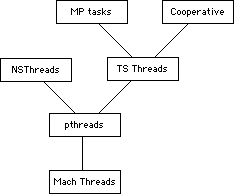No more mysteries: Apple's G5 versus x86, Mac OS X versus Linux
by Johan De Gelas on June 3, 2005 7:48 AM EST- Posted in
- Mac
Mac OS X: beautiful but...
The Mac OS X (Server) operating system can't be described easily. Apple:
While there are many very good ideas in Mac OS X, it reminds me a lot of fusion cooking, where you make a hotch-potch of very different ingredients. Let me explain.

Hexley the platypus, the Darwin mascot
Everything else is located in smaller programs, servers, which communicate with each other via ports and an IPC (Inter Process Communication) system. Explaining this in detail is beyond the scope of this article (read more here). But in a nutshell, a Mach microkernel should be more elegant, easier to debug and better at keeping different processes from writing in eachother's protected memory areas than our typical "monolithic" operating systems such as Linux and Windows NT/XP/2000. The Mach microkernel was believed to be the future of all operating systems.
However, you must know that applications (in the userspace) need, of course, access to the services of the kernel. In Unix, this is done with a Syscall, and it results in two context switches (the CPU has to swap out one process for another): from the application to the kernel and back.
The relatively complicated memory management (especially if the server process runs in user mode instead of kernel) and IPC messaging makes a call to the Mach kernel a lot slower, up to 6 times slower than the monolithic ones!
It also must be remarked that, for example, Linux is not completely a monolithic OS. You can choose whether you like to incorporate a driver in the kernel (faster, but more complex) or in userspace (slower, but the kernel remains slimmer).
Now, while Mac OS X is based on Mach 3, it is still a monolithic OS. The Mach microkernel is fused into a traditional FreeBSD "system call" interface. In fact, Darwin is a complete FreeBSD 4.4 alike UNIX and thus monolithic kernel, derived from the original 4.4BSD-Lite2 Open Source distribution.
The current Mac OS X has evolved a bit and consists of a FreeBSD 5.0 kernel (with a Mach 3 multithreaded microkernel inside) with a proprietary, but superb graphical user interface (GUI) called Aqua.
Performance problems
As the mach kernel is hidden away deep in the FreeBSD kernel, Mach (kernel) threads are only available for kernel level programs, not applications such as MySQL. Applications can make use of a POSIX thread (a " pthread"), a wrapper around a Mach thread.
Mac OS X thread layering hierarchy (Courtesy: Apple)
In order to maintain binary compatibility, Apple might not have been able to implement some of the performance improvements found in the newer BSD kernels.
Another problem is the way threads could/can get access to the kernel. In the early versions of Mac OS X, only one thread could lock onto the kernel at once. This doesn't mean only one thread can run, but that only one thread could access the kernel at a given time. So, a rendering calculation (no kernel interaction) together with a network access (kernel access) could run well. But many threads demanding access to the memory or network subsystem would result in one thread getting access, and all others waiting.
This "kernel locked bottleneck" situation has improved in Tiger, but kernel locking is still very coarse. So, while there is a very fine grained multi-threading system (The Mach kernel) inside that monolithic kernel, it is not available to the outside world.
So, is Mac OS X the real reason why MySQL and Apache run so slow on the Mac Platform? Let us find out... with benchmarks, of course!










116 Comments
View All Comments
edchi - Tuesday, June 26, 2007 - link
I haven't tried this yet, but will do tomorrow. Here is what Apple suggests to create a better MySQL installation:
http://docs.info.apple.com/article.html?artnum=303...">http://docs.info.apple.com/article.html?artnum=303...
grantma - Tuesday, April 18, 2006 - link
I found Gnome was a lot more snappy than OS X desktop under Debian PowerPC. You could tell the kernel was far faster using Linux 2.6 - programs would just start immediately.heaneyforestrntpe68 - Thursday, October 21, 2021 - link
At least the non-ECC RAM, that is. https://bit.ly/2XwdzPtpecosbill - Wednesday, June 15, 2005 - link
I'm not going to waste my time searching to see if these same comments below were made already, but the summary of them is those who are performance oriented tune their code for a CPU. You can do the same for an OS. Also, the "Big Mac" cluster in VA tech speaks otherwise to raw performance as OS X was the OS of choice. From macintouch.com:Okay, stop, I have to make an argument about why this article fails, before I explode. MySQL has a disgusting tendency to fork() at random moments, which is bad for performance essentially everywhere but Linux. OS X server includes a version of MySQL that doesn't have this issue.
No real arguments that Power Macs are somewhat behind the times on memory latency, but that's because they're still using PC3200 DDR1 memory from 2003. AMD/Intel chips use DDR2 or Rambus now ... this could be solved without switching CPUs.
The article also goes out of its way to get bad results for PPC. Why are they using an old version of GCC (3.3.x has no autovectorization, much worse performance on non-x86 platforms), then a brand spanking new version of mySQL (see above)? The floating point benchmark was particularly absurd:
"The results are quite interesting. First of all, the gcc compiler isn't very good in vectorizing. With vectorizing, we mean generating SIMD (SSE, Altivec) code. From the numbers, it seems like gcc was only capable of using Altivec in one test, the third one. In this test, the G5 really shows superiority compared to the Opteron and especially the Xeons"
In fact, gcc 3.3 is unable to generate AltiVec code ANYWHERE, except on x86 where they added a special SSE mode because x87 floating point is so miserable. This could have been discovered with about 5 minutes of Google research. It wouldn't had to have been discovered at all if they hadn't gone out of their way to use a compiler which is the non-default on OS X 10.4. Alarm bells should have been going off in the benchmarkers head when an AMD chips outperforms an Intel one by 3x, but, anyway ...
I hate to seem like I'm just blindly defending Apple here, but this article seems to have been written with an agenda. There's no way one guy could stuff this much stuff up. To claim there's something inherently wrong with OS X's ability to be a server is going against so much publicly available information it's not even funny. Notice Apple seems to have no trouble getting Apache to run with Linux-like performance: [Xserve G5 Performance].
Anyway ... on a more serious note, a switch of sorts to x86 may not be a hugely insane idea. IBM's ability to produce a low power G5 part seems to be seriously in question, so for PowerBooks Apple is pretty much running out of options. Worse comes to worst - if they started selling x86-powered portables, that might get IBM to work a bit harder to get them faster desktop chips.
-- "A Macintosh MPEG software developer"
christiansen89 - Monday, December 6, 2021 - link
Guess there's no one arguing that the PPC is not keeping its pace with the current market, but rather OS/X able to do Big Iron computing. And if rumors are true, where will you be able to get a PPC built once Apple drops IBM for Intel? https://tvzyon.com/aladdin0tw - Tuesday, June 14, 2005 - link
This is my first time to see someone use 'ab' command to conduct a test, and trying to tell us something from the test.In my opinion, ab is never a 'stress test' tool for any reason, especially when you want to conclude some creditable benchmark from this test. If we can accept 'ab', why I have to code so much for a stress test?
The 'localhost' is another problematic area, DNS. Why not using a fixed ip as an address? The first rule of benchmaking is isolated the domain in question, but I can not see you obey these rule. So how can you interpret your result as a performance faulty, not a dns related problem?
I think you should benchmark again, and try some good practices used in software industry.
Aladdin from Taiwan
demuynckr - Sunday, June 12, 2005 - link
jhagman, the number in the apache test table means the request per second that the server handles.jhagman - Wednesday, June 8, 2005 - link
Hi again, demuynckr.Could you please answer to me, or preferably add the information to the article. What the does the number in the apache test table mean and what kind of a page was loaded?
I assumed that the numbers given were hits per second or transfer rate. I've been testing a bit on my powerbook (although with a lower n) and I can very easily beat the numbers you have. So it is apparent that my assumption was wrong.
BTW, gcc-3.3 on Tiger knows the switch -mcpu=G5
rubikcube - Wednesday, June 8, 2005 - link
I thought I would post this set of benchmarks for os x on x86 vs. PPC. Even though XBench is a questionable benchmark, it still is capable of vindicating these questions about linux-ppc.http://www.macrumors.com/pages/2005/06/20050608063...
webflits - Wednesday, June 8, 2005 - link
"Yes I have read the article, I also personally compiled the microbenchmarks on linux as well as on the PPC, and I can tell you I used gcc 3.3 on Mac for all compilation needs :)."I believe you :)
But why my are results I get way higher than the numbers listed in the article?